
Yellowstone National Park is one of the most interesting National Parks in the world. It was founded in 1872 as the United States first National Park. It’s located in Northwest Wyoming and home to a high concentration of the most unique geologic wonders on earth.
The park covers over 2.2 million acres, with tons of diverse landscapes to explore. From erupting geysers and vibrant hot springs to mesmerizing waterfalls and strikingly colorful canyons. There are tons of attractions to witness within this stunning park.
This post may contain affiliate links. Disclosure policy.
The entrance fee into Yellowstone National park is $35 per vehicle, good for 7-days. Or you can purchase an America The Beautiful Annual Pass for $80, which usually pays itself off in 3 visits to any other National Parks in the US. And with Grand Teton National Park right next door, that’s already two parks right there.
Refer to our custom map for help locating our favorite Yellowstone attractions
Now, let’s get into the top 10 things to do in Yellowstone National Park.
Old Faithful

This is one of the most reliably active geysers in the park. Viewing Old Faithful is like natures firework show. It erupts about 20 times a day. So if you’re patient, you can’t miss it.
You will most likely see the crowds that form around this geyser when it is about to go off. But you can also check with a ranger in the visitor center for their estimated schedule or refer to their online schedule.
When the geyser erupts it can reach up to 184 feet in the air which is just mesmerizing. And an eruption can last up to 5 minutes.
There is an easy .7 mile loop around the geyser or you can pair it with the Upper Geyser Basin Loop, listed below.
Upper Geyser Basin
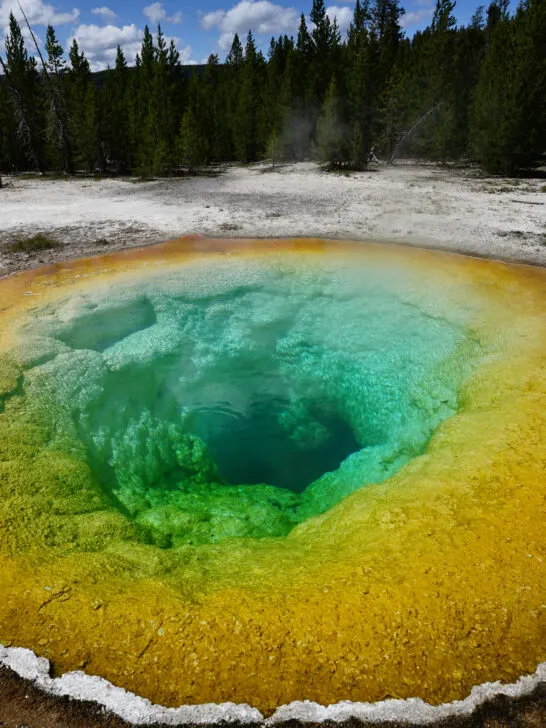
After you’re done marveling at Old Faithful, continue hiking along Upper Geyser Basin. It’s a flat 4.5 mile walk around to tons of other unique geysers. Check the whiteboards near the active geysers for predicted eruptions times. Or to see when the last time a geyser erupted.
The real star of the show is Morning Glory Pool. It’s bright colors and deep pool are just amazing for the eye to see. The colors range from an aqua blue, bright green, yellow and orange. Plus, you can actually get right up close to it! But the bright colors have faded over the years because people have sadly thrown objects into the pool clogging it up. So please be respectful and only look at its beauty so others can enjoy it for many years to come.
Grand Prismatic Spring

This is the largest hot spring in the United States. And our personal favorite natural feature in Yellowstone. The vibrant colors and sheer size are what make Grand Prismatic so jaw-dropping.
And There are two different ways to see it.
We highly suggest hiking up to the scenic Overlook. The hike is 1.5 miles roundtrip. The hike starts off on a flat wide trail, and then gradually climbs up 200 ft to a view above the spring. This top down view really allows you to see the colors of the pool.
The other way is to walk the Midway Geyser Basin Trail. This easy 1.6-mile loop takes you along boardwalks right up close to the spring. You can also explore The Excelsior Geyser, Opal Pool, and Turquoise Pool. You don’t see the colors as well from this perspective. But instead are immersed in the sounds and smells bubbling up all around you.
West Thumb Geyser & Yellowstone Lake
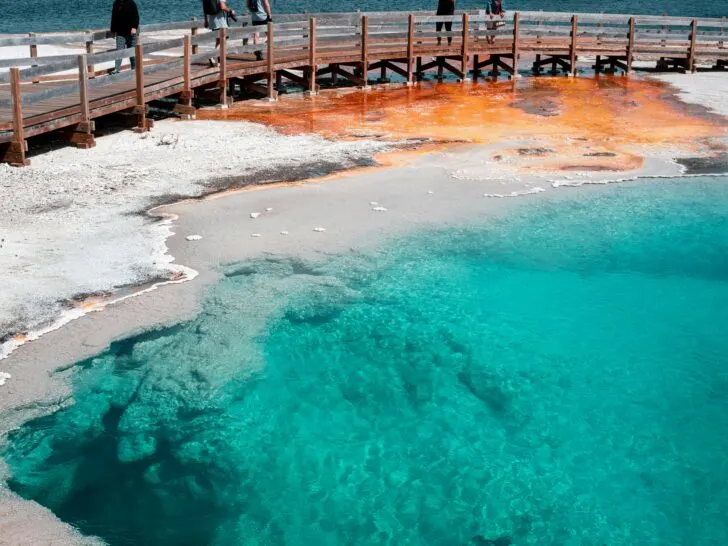
West Thumb Geyser is another cluster of geothermal features right along the shores of Yellowstone Lake.
Most of these geysers are aqua blue or white, which is personally my favorite color!
There are two loops to explore the various geysers in the area. The outer loop is a ½-mile, and the inner loop is a ¼-mile.
The Abyss Pool is one of the most remarkable geysers along the walk. It is known for it’s depth that extends over 50 feet down.
Yellowstone Lake
You will notice Yellowstone Lake in the background. Which is the largest freshwater lake above 7,000 feet. So, it’s not really popular for swimming, because it doesn’t really reach much about 40 degrees Fahrenheit (5°C).
So boating and fishing are the most popular activities on the lake.
A fun way to get out on the water is via a scenic cruise, which usually runs mid-June to mid-September.
Or you can book a guided kayaking tour around the lake. Here is a great morning kayaking tour and a sunset kayaking tour.
Or you can use your own boat or kayak, but under strict requirements. You must have a current Yellowstone Aquatic Invasive Species inspection and boat permit to launch in Yellowstone Lake.
Grand Canyon Of The Yellowstone
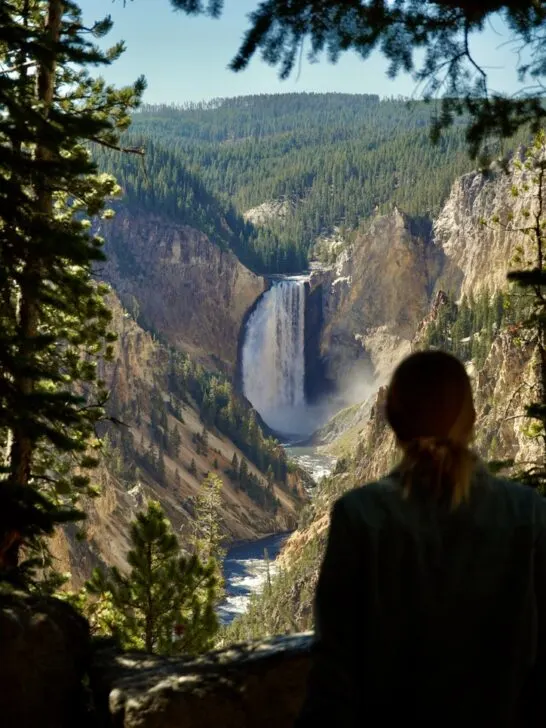
It might not be as Grand as the Grand Canyon in Arizona, but it’s beautiful and impressive in its own way. This canyon is layered with striking colors, and the waterfalls and river flowing through is straight out of a fairytale.
A popular thing to do is explore North Rim Drive and stop at the various viewpoints along the way. Some viewpoints include a little hiking, but most are a super easy stop just a quick walk from the parking lot.
Or you can drive along the South Rim to other viewpoints and hiking trailheads.
Our personal favorite stop is Artist Point. You get an amazing view of the waterfall, between a long span of the beautiful canyon walls.
If you’re looking for a variety of views, the North Rim is better. But if you want one epic view, Artist Point is all you need.
Mammoth Hot Springs
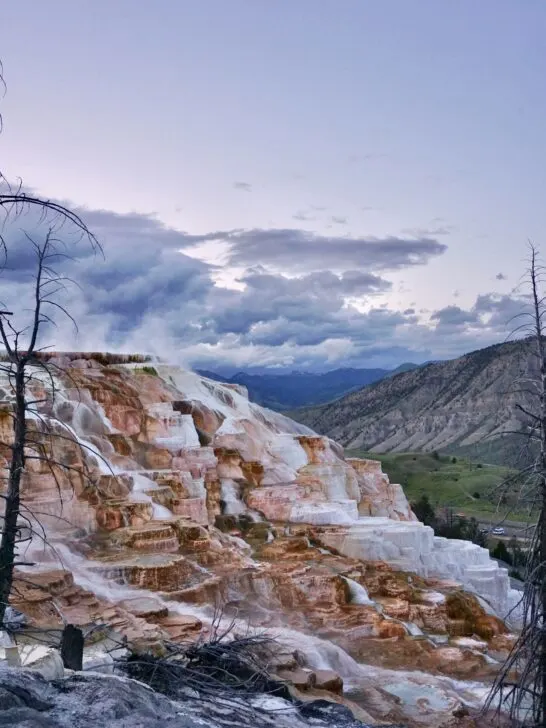
These massive terraced springs are unique landscapes like nowhere else in Yellowstone. Layers of colorful limestone rock and steaming spring water create this unique scene.
Basically a network of fractures and fissures underneath allow for water from snow and rain that has seeped into the ground to resurface and create these amazing limestone terraces.
Travertine builds up and forms the formations we see today. But, they can change often and vents can clog moving the water to a new spot.
There is a 3.5 mile scenic walk around to the different terraced springs, which is definitely worth it.
Two of our favorite springs were Canary Spring, and Mound & Jupiter Terraces. So be sure to at least check out these two amazing springs!
Gibbon Falls

This is an amazing roadside waterfall that really doesn’t require much extra effort. A small parking lot is conveniently located just off the highway, providing direct access to a breathtaking overlook of the falls.
The waterfall cascades 84 feet over the rim, and a path runs along the canyon’s edge, offering various vantage points to admire its beauty.
Norris Geyser Basin

This is Yellowstones hottest, oldest, and most dynamic thermal area. There are two different sections to explore via a figure 8 loop hike.
The Porcelain Basin section is 3/4 of a mile and opens up to a large geothermal area. The upper boardwalks offer a top-down view of the area with views of the little sputtering geysers and a wide array of colorful and milky pools.

Then, head down to toward the geothermal area, where boardwalks guide you along the area, getting up close to some unique features.
The back basin loop is 1.5 miles, and roams through a more wooded section. You can also witness Steamboat Geyser along this route. Which is the world’s tallest active geyser. But this geyser doesn’t go off very consistently.
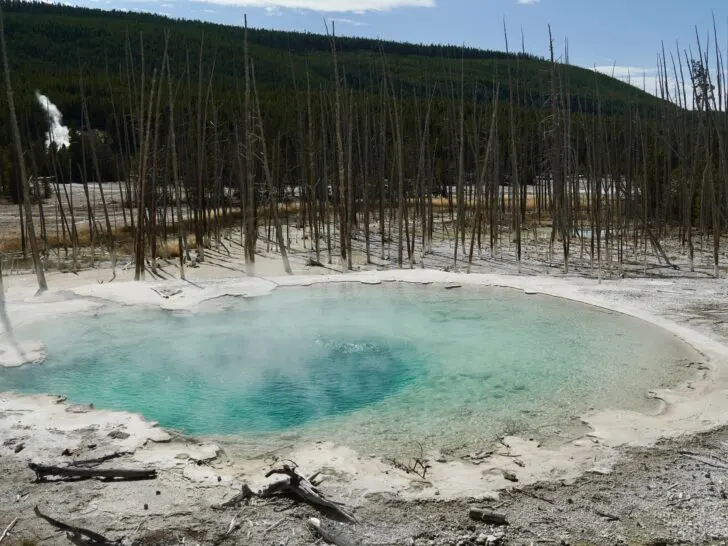
At its peak, this geyser has erupted up to 48 times in a single year, yet it has also gone 50 years without any activity. During major eruptions, it can blast water over 300 feet (91 meters) into the air. So, if you’re lucky enough to witness an eruption, consider it a rare and incredible sight!
We also enjoyed a mystical looking forest here, where the geysers have turned the trees into barren white skeletons.
Also, check out the Norris Musuem, which goes more into depth about geothermal activity and life in thermal areas. There are often rangers roaming around this area, so if you have any questions, they are sure to be of help.
Firehole Canyon
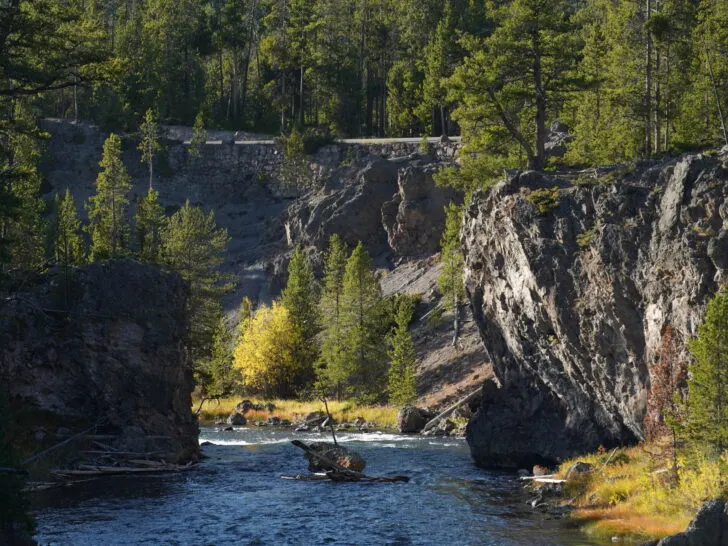
This canyon is often overlooked, but can easily be added to your Yellowstone itinerary without taking up much extra time. When driving south via Madison Junction, there is a one-way road that takes you through this canyon.
One of the stops along the road offers a beautiful view of a 40-foot waterfall.

There is also a public swimming area at the end of the road. Check with a ranger or on their website, as it does experience seasonal closures.
See Some Wildlife

Yellowstone is one of the best National Parks to witness wildlife. While, it’s not something you can specifically plan for, you are almost guaranteed to see bison, deer and smaller animals like squirrels and chipmunks roaming the park. But you can also get lucky to see grizzly bears, black bears, elk, wolves, etc.
A rule of thumb, is if you see a bunch of cars lined up on the side of the road, well if it’s not a trailhead, there is most likely some wildlife within view. But DO NOT stop in the road and be sure to use official pull offs.
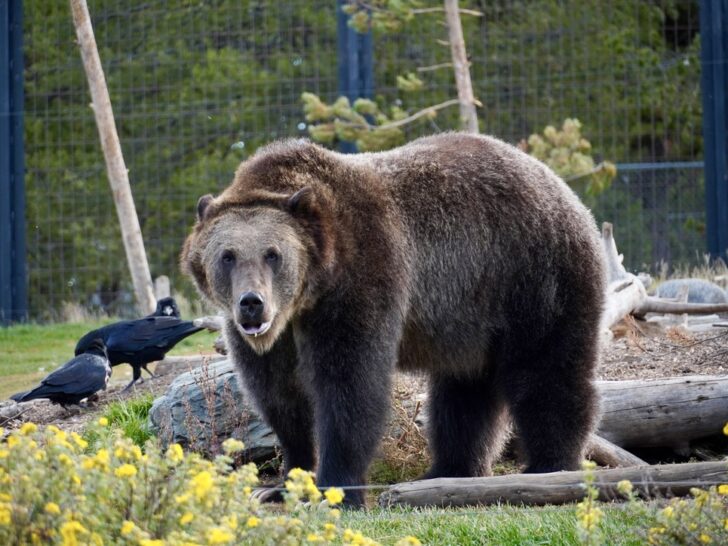
Remember, wildlife are…. Wild. So you should NEVER get too close to a wild animal. Generally, if they react to your presence, then you are too close. And absolutely DO NOT feed any wildlife.
This is another reason we highly recommend Binoculars and/or zoom lens for appreciating the wildlife in the park.

If you didn’t see as much wildlife as you were hoping, head to the Grizzly & Wolf Discovery Center in West Yellowstone, MT. This is the best way to be guaranteed to see some grizzly bears, wolves, birds, otters, fish and more. It was truly awesome to be so close the these animals, because in reality, if you are this close in the wild, you could easily become this afternoon’s snack….
There is also the Yellowstone Wildlife Sanctuary in Red Lodge, MT.
Or consider booking a private tour to explore the wildlife around the park. This can be a great way to guarantee seeing some wildlife in the park.
Ideal Yellowstone National Park Itinerary
You might be wondering, how much time you need to explore Yellowstone? While you can fit a lot of these stops into one day (check out our Yellowstone 1-day itinerary), but it will feel rushed and you will likely be exhausted. So we suggest at minimum consider staying for 2-days. There are tons of great campgrounds in the park, or you can stay at some historic hotels in the area (listed below).

The West Entrance is the most popular starting point. Here is an ideal itinerary entering from the West Entrance.
Day 1
- Firehole Canyon Loop
- Old Faithful
- Upper Geyser Basin
- Grand Prismatic Spring
- Yellowstone Lake & West Thumb Geyser
- Stay At Grant Village or camp at Grant Village Campground
Day 2
- Grand Canyon Of The Yellowstone (Drive the North Rim to different viewpoints & south rim to Artist Point)
- Norris Geyser Basin
- Mammoth Hot Springs
- Gibbon Falls
- Grizzly & Wolf Discovery Center (if exiting out the West Entrance)
In the summer, this does a grand loop around to all the best attractions in Yellowstone National Park. (Do note the Grand Loop Rd is closed in winter)
Where To Stay In Yellowstone National Park
Here are a few hotels within the park that offer a comfortable and historic place to stay.
- Mammoth Hot Springs Hotel & Cabins (North) – Built in 1936, restaurants on site
- Old Faithful Inn (West) – Built in 1903-1904, restaurants on site
- Grant Village (South) – Built in 1984, restaurants on site
- Lake Yellowstone Hotel & Cabins (East) – A National Historic Landmark, restaurants on site
Here are a few great campgrounds within the park:
- Mammoth Campground (North) – limited facilities, no showers (no hook-ups)
- Madison Campground (West) – limited facilities, no showers (no hook-ups)
- Slough Creek Campground (East) – limited facilities, no showers (no hook-ups)
- Grant Village Campground (South) – all campground facilities (no hook-ups)
- Canyon Campground (Central) – all campground facilities (no hook-ups)
- Fisher Bridge RV Park (Central) – all campground facilities (including hook-ups)
- Flagg Ranch (Free camping outside the South Entrance), drop toilet, no other facilities
- S Plateau Rd (FS1700) (Free camping outside the West Entrance), no facilities
Yellowstone National Park Packing List
- Hiking day pack – Here’s everything we like to pack inside
- Good pair of hiking shoes
- Sunscreen/sun protection
- Re-usable water bottle
- Binoculars – Great for viewing wildlife
- Camera (zoom lens)
- Rain Jacket
- Jacket – always pack layers, weather can change often
- Bear Spray – Learn more about bear safety
- Bug Spray – Learn about our favorite bug repellents
- Toilet paper/hand sanitizer (usually limited facilities within the park)
- Hiking poles (optional) – most trails are pretty flat along boardwalks
- Self-guided audio tour – learn about the history of the park as you drive through the park
Be Sure To Leave No Trace: When exploring these treasured outdoor spaces, you are responsible for understanding and following Leave No Trace Guidelines. Most importantly: pack out all garbage, travel only on trails and durable surfaces, and follow local rules for campsites and human waste disposal.
Save This Post For Later


